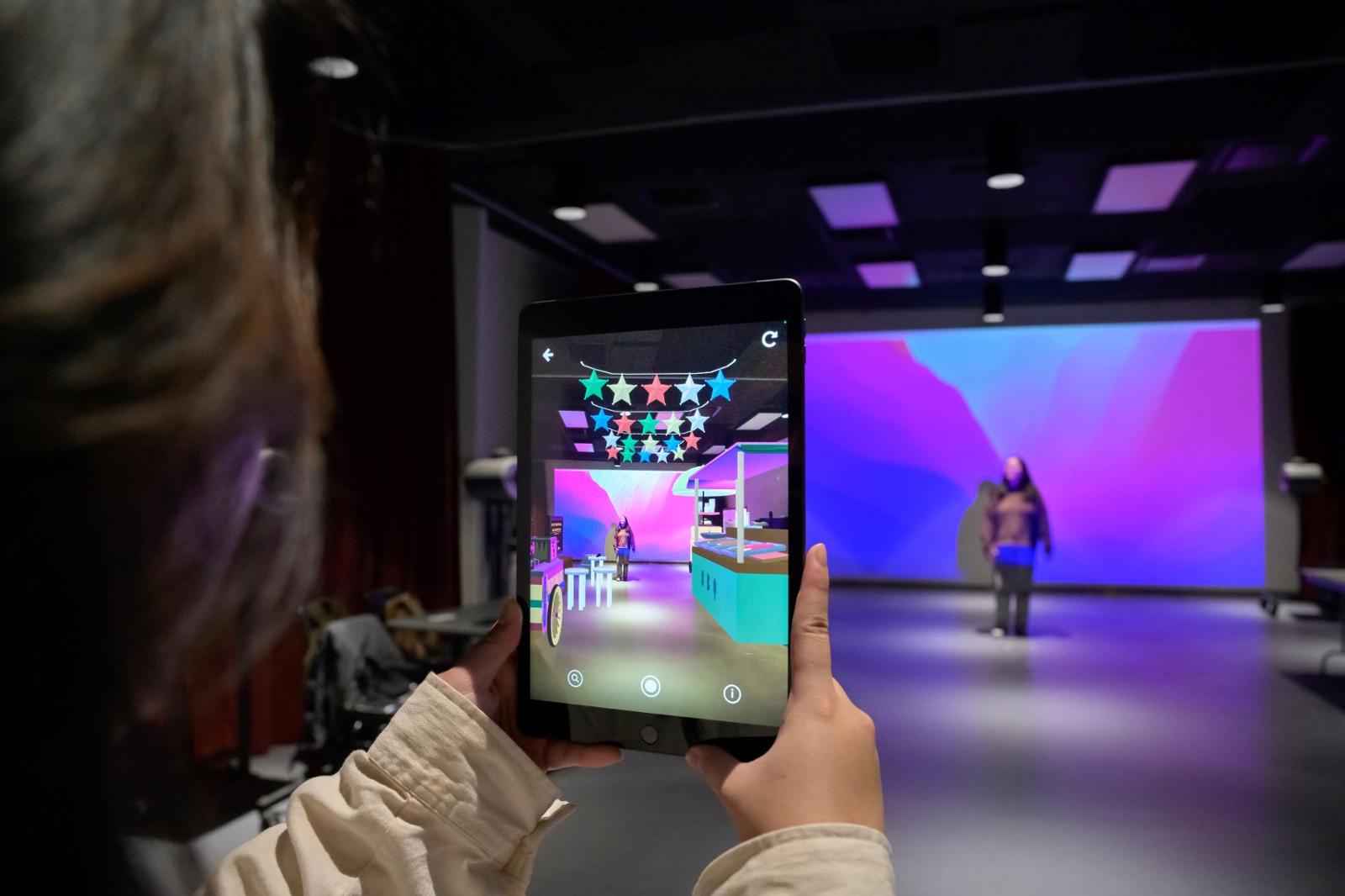
Design
Take your skills in design and creative problem-solving to the next level with the U of R Bachelor of Design degree.
Design is for students who have an interest in design, technology, art, culture, and interdisciplinary study. Explore digital culture while working in visual communication and graphic design, physical computing, creative computation, VR design, AR design, interactive media and installation, and sound design. The U of R’s innovative programs in Creative Technologies & Design are unique in Saskatchewan and across the prairie provinces.
Our students develop skills as designers, artists, scientists, developers, theorists, entrepreneurs, and practice-based scholars, as they learn to think about creative technologies and design in new and critical ways.
Design encourages collaboration, experimentation, play, and thinking outside the box. Our programs cultivate imaginative and innovative outcomes inspired by our changing technological landscape.
For students who have completed a 2-year diploma in design from an approved Canadian institution, the Bachelor of Design program offers a seamless pathway to complete their degree in just 2 additional years. Who’s Eligible?
University of Regina:
- Creative Technologies Diploma
- Computer Science Diploma
Saskatchewan Polytechnic:
- Graphic Communications Diploma
- Interactive Design and Technology Diploma
- Engineering Design and Drafting Technology Diploma
Graduates are design practitioners and researchers who have the skills to address the needs of diverse audiences through design thinking. Design graduates work in the forefront of emerging and established industries, blending creativity and expression with interdisciplinary expertise.
Graduates will be in-demand by a wide variety of industries for their skills as creative and critical thinkers who can combine imagination and innovation with design.
Professional placements offer industry experience.
Design Meet Your Faculty
Quick Facts
Connect with us
Our Bachelor of Design program is part of our Creative Technologies and Design area of study, where the arts, sciences, technology, and culture meet to create new ways of thinking and new opportunities for our students. Examples include multi-sensory experiences made using computer graphics, 3D animation, digital storytelling, video production, digital music, virtual reality, augmented reality, video editing, software engineering, 3D printing, sound art, computer gaming, interactive media, and wearable technologies.
Some courses include:
CTCH 204 - Introduction to Creative Coding
This course introduces core creative coding methods and strategies for computational art.
CTCH 213 - Branding, Advertising and Design
This course explores design practices for branding and advertising as they are developed in a professional environment. Through experiential learning process, lectures, case studies, and studio projects, students will gain practical and theoretical knowledge to create and understand the visual language underpinning brand identities and advertising campaigns.
CTCH 215 - Visual Identity Design
In this course you will design visual communication for businesses and non-profit organizations. Through a combination of projects, you will design and publish documents for internal and external publics, connecting with your audience through print and web media products.
CTCH 216 - 3D Animation: Art, Social Media
An online real-time interactive software intensive course that addresses digital art, design, DE animation [TS5] and modeling
CTCH 306 - Digital Storytelling and Interactive Media
This course explores the social, political, cultural, economic, and intersectionality of interactive media and digital storytelling. We will engage with audio (audio walking tours, music recording, podcasting, radio programming) and online interactive and immersive storytelling (web-projects, gaming, apps).
CTCH 312 - Introduction to Computer Game and Virtual Reality Design
This course introduces computer game design using Unity and other industry standard software, through concept, pre-production, production and post-production; includes storyboarding and distribution. For game design, and virtual reality composition towards experimental art applications.
CTCH 314 - 3D Animation Design: Story, Character, and Motion
Advanced studies in 3D modelling/animation for Industry and Entertainment. Studies will include opportunities to learn character modelling, rigging and animation. Applications for motion graphics and visual effects (VFX). Professional 3D portfolio for media and industry are covered.
CTCH 301 - Play
Play is a core, hands-on studio course which critically investigates participation, interaction, and play within new media art practice. Students will build projects in the areas of interactive installation or performance, data translation, and interactive games.
CTCH 313 - Augmented Reality: Critical Theory, Art, and Activism
Students will engage with AR artworks and examine how artists and activists are creating AR art to further social change. Reading scholarly works on AR art as strategies for social justice, students will explore issues related to participatory place-based art/media and learn AR technologies during labs/workshops.
CTCH 302 - Augmentation
Augmentation explores "wearables" technologies and techniques in art practice. Students will create wearable projects and learn about critical concepts, and global and emerging practices which address technological augmentation of the body in art and design.
Why Study Creative Technologies and Design at the University of Regina?
This innovative interdisciplinary program encourages research and creation outside of and across traditional areas of study. Designers, artists, scientists, and cultural theorists converge and explore new approaches to art-making and creative problem-solving that re-imagine the impact and power of technology within the fine arts and the creative industries.
You will benefit from the extensive experiential learning and hands-on training obtained during your college diploma, followed by all the advantages of a degree. This requires only an additional two years of study, rather than the four years normally required for a bachelor’s degree.
Creative possibilities and innovation
Our courses also supplement traditional study in Fine Arts. For example, imagine:
- How an artist can make their art interactive and accessible to more audiences with Augmented Reality
- How real-time interactivity through the incorporation of custom electronics enriches the process of making art installations
- How the development and programming of topic-sensitive mobile apps augments a course in performance theatre
- How a course working with a tablet as an instrument broadens traditional music training by including new media
- How a course in expanded cinema enhances approaches to animation
- How 3D modeling, laser cutting and rapid prototyping facilitates new avenues in sculpture
In Creative Technologies and Design, the possibilities are limitless.
Facilities
- Interactive Media Performance (IMP) Lab
- Creative Technologies Maker Space
- MAP Sound Studio (ED 242)
- Film Production Studios
- Production Studio
- Photography lab with a 12-station dark room
- Animation classroom
- Printmaking Studio
- Digital Photography Studio
- Music Studios
- Costume Shop and Set Design space
- Shumiatcher Theatre
- University of Regina Theatre
- The Fifth Parallel Gallery
- The Art Store
- Voice Mapping Lab
- Centre for Socially Engaged Theatre (C-SET)
Professional placement options
The Faculty of Media, Art, and Performance professional placement option is an experiential learning course, similar to an internship. Through it, you can further knowledge and skills in an organization related to your major, and at the same time, earn credit towards your degree.
Expert professors and instructors
All of our professors and instructors are recognized scholars, artists and/or professionals in their fields, including Creative Technologies, Design, Interactive Media and Performance, Media Studies, Popular Music, Film Production, Theatre, and Visual Arts.

I have been drawing and painting since I was young but I never imagined myself taking classes in engineering or computer science. I was very surprised when I took a computer science class and learned to program wearable technologies. It turned out to be one of my favourite classes.
Design Frequently Asked Questions
To enter this program, you must hold one of the following:
- Diploma of Graphic Communications from Saskatchewan Polytechnic
- Diploma of Interactive Design and Technology from Saskatchewan Polytechnic
- Diploma of Engineering Design and Drafting Technology from Saskatchewan Polytechnic
- Diploma in Creative Technologies at the U of R
- Diploma in Computer Science at the U of R
- Diploma in Design at an approved Canadian institution
Credentials from elsewhere in Canada will be approved on a case-by-case basis.
Yes! We offer the following scholarships to creative technologies students:
- Media, Art, and Performance Entrance Award in Creative Technologies
- Gene B. Ciuca Memorial Award in Media, Art and Performance
Students enrolled in any Faculty of Media, Art, and Performance undergraduate program may also be eligible for the following awards:
- Anthony Kay Scholarship (Preference to Visual Arts) (February 1)
- Faculty of Fine Arts Scholarships (October 1)
- Gene B. Ciuca Memorial Scholarships (February 1)
- McConica Family Legacy Scholarship in Fine Arts (October 1)
- Styles Family Foundation Bursary (February 1)
Use our online Student Awards Management System (SAMS) to find other awards and scholarships for which you may be eligible.
- IMP Lab and Maker Space Workshop Series Program
- Creative Technologies Student Society Programming and Events
- MAP Student Society Programming and Events
- MAP Presentation Series
- Art for Lunch
- 5th Parallel Art Gallery
- Living Skies Student Film Festival
- Theatre Productions
- Music Performances
- Clubs and activities open to all U of R students
Creative Technologies students have also showcased artworks in festivals such as Nuit Blanche, Frost Regina, as well as in Neutral Ground’s event Art’s Birthday.
What Can You Do with a Design Degree?
Upon successfully completing your bachelor’s degree in Creative Technologies & Design, you will be prepared for the next steps of your career. You may find employment at web design firms, software studios, mobile app design agencies, animation and gaming design companies, non-profit arts organizations, marketing or advertising agencies, production companies, and other creative industry sectors.
To explore minors that may be available in this program area, please visit the Academic Calendar or meet with your faculty advisor in the Academic Advising Office after you are admitted.
Graduates go on to jobs such as:
- Designer
- Creative Technologist
- Mobile App Developer
- Game Developer
- Virtual Reality Designer
- Production Engineering Specialist
- Technical Art Director
- Animator
- Web Programmer
- Interactive Media Specialist
- Marketing and Communications Specialist
- Contemporary Artist
Related Programs
